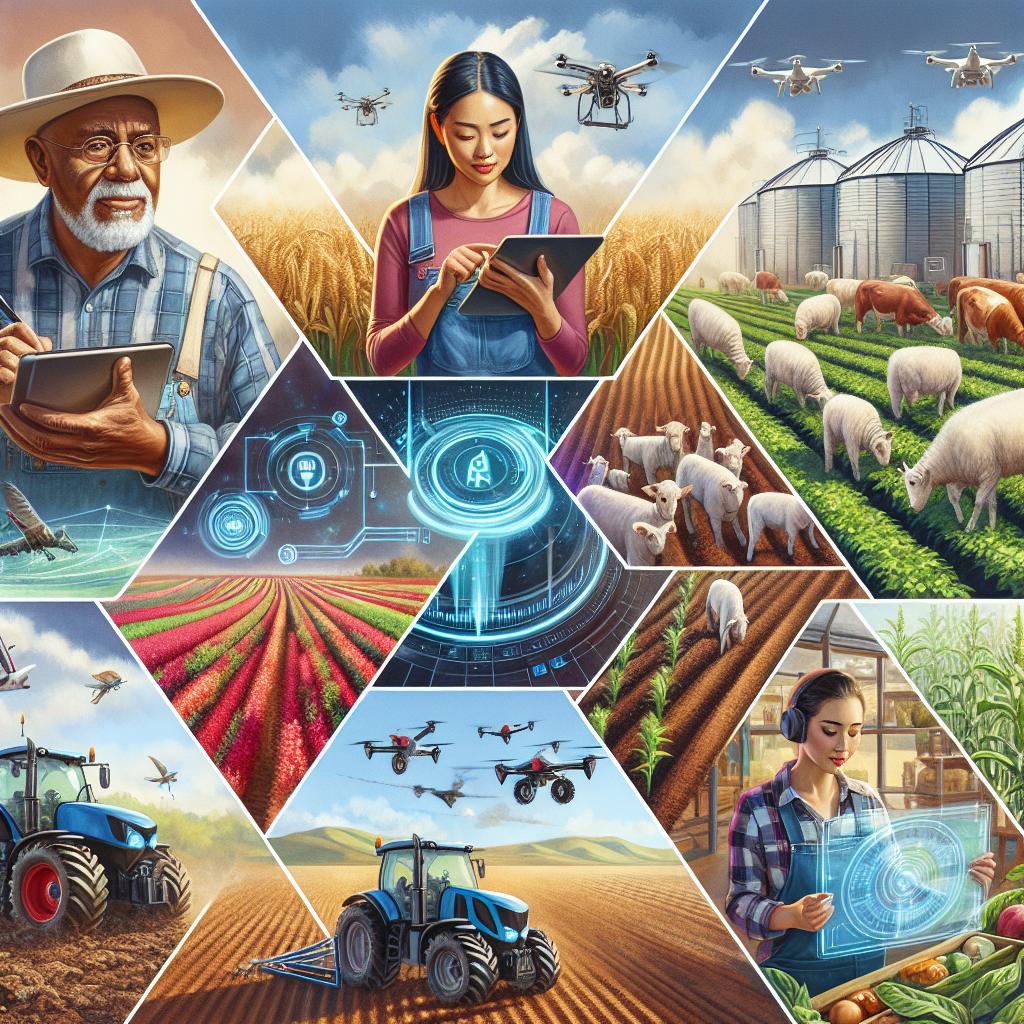This post may contain affiliate links which means I may receive a commission for purchases made through links. Learn more on my Private Policy page.
In an age where technology intertwines seamlessly with agriculture, the landscape of farming is undergoing a profound transformation. Gone are the days when farmers relied solely on intuition and experience to manage their operations. Today, the advent of farm management software has revolutionized the way equipment is monitored and maintained, paving the way for increased efficiency and productivity. This digital revolution not only streamlines workflows but also empowers farmers with insights that were once only accessible through labor-intensive methods. In this article, we’ll explore the myriad benefits of utilizing farm management software for monitoring equipment, unveiling how this innovative tool can enhance operational effectiveness, reduce downtime, and ultimately contribute to a more sustainable agricultural practice. Whether you’re a seasoned farmer or a newcomer to the field, understanding the value of this technology might just be the key to unlocking your farm’s full potential.
Enhancing Operational Efficiency through Real-Time Equipment Monitoring
Incorporating farm management software to monitor equipment in real-time can significantly amplify operational performance on the farm. By utilizing advanced technologies such as IoT sensors and wireless connectivity, farmers can gain immediate insights into equipment status, usage patterns, and preventive maintenance needs. This capability not only reduces downtime but also leads to optimal resource allocation. Key benefits include:
- Improved Decision-Making: Access to real-time data enables quicker, more informed decisions regarding equipment deployment and upgrades.
- Minimized Downtime: Early detection of issues can prevent breakdowns and associated costs.
- Enhanced Productivity: Efficient monitoring allows farmers to maximize the use of their machinery during critical periods.
Moreover, real-time equipment monitoring fosters a culture of proactive management within farming operations. Data analytics can be employed to track performance metrics and generate reports detailing wear and tear, fuel consumption, and operational efficiency. This data is invaluable for strategic planning, enabling farmers to forecast future equipment needs based on historical patterns. The impact is substantial, as illustrated in the table below:
| Metric | Before Real-Time Monitoring | After Real-Time Monitoring |
|---|---|---|
| Average Downtime (hours/week) | 10 | 3 |
| Equipment Utilization (%) | 60 | 85 |
| Maintenance Costs (monthly) | $2,000 | $800 |

Streamlining Maintenance Schedules with Advanced Analytics
Advanced analytics in farm management software can significantly enhance the way farmers create and manage maintenance schedules for their equipment. By leveraging data-driven insights, equipment performance metrics and historical maintenance records can be analyzed to predict when maintenance is needed, minimizing downtime and preventing costly repairs. This proactive approach ensures that any issues are addressed before they escalate, leading to an increase in efficiency and productivity. Key benefits include:
- Data-Driven Decisions: Utilize historical data to identify optimal maintenance periods.
- Cost Efficiency: Reduce emergency repairs by scheduling routine check-ups based on actual usage data.
- Improved Equipment Lifespan: Regular maintenance extends the life of machinery, maximizing investment returns.
- Real-Time Monitoring: Enable real-time updates on equipment condition through IoT integrations.
Furthermore, a well-structured maintenance schedule, powered by advanced analytics, can lead to a more organized operation overall. Farmers can visualize maintenance timelines alongside crop planning and weather forecasts, ensuring all aspects of their operations are aligned for peak efficiency. By integrating various data sources into a cohesive maintenance dashboard, users can easily track upcoming maintenance tasks, prioritize effectively, and manage labor resources. An example of typical data displayed within the software might look like this:
| Equipment | Last Serviced | Next Service Due | Status |
|---|---|---|---|
| Tractor A | 2023-01-15 | 2023-07-15 | Due Soon |
| Harvester B | 2023-02-10 | 2023-08-10 | On Schedule |
| Plow C | 2023-03-05 | 2023-09-05 | Check Performance |

Maximizing Crop Yields by Integrating Equipment Data
Integrating equipment data into your farm management software not only streamlines daily operations but also plays a pivotal role in enhancing crop productivity. By harnessing real-time data from various machinery, farmers can make informed decisions that amplify their yields. Key benefits of utilizing this integration include:
- Precision Monitoring: Track the performance of each piece of equipment to ensure optimal operation, reducing downtime and inefficiencies.
- Data-Driven Insights: Analyze historical performance data to identify trends and adjust practices for better crop outcomes, maximizing every acre’s potential.
- Interconnected Systems: Enable communication between different equipment, allowing for coordinated actions that enhance overall farm efficiency.
Moreover, by employing advanced analytics derived from integrated equipment data, farmers can pinpoint ideal planting and harvesting windows, effectively responding to changing climate conditions. Utilizing a centralized dashboard, farmers can quickly assess variables such as soil moisture levels and machinery output, ensuring that their strategies are as responsive as possible. The following table outlines some crucial data points that can inform decision-making:
| Data Point | Importance |
|---|---|
| Soil Moisture Levels | Indicates the best times for irrigation and planting. |
| Fuel Efficiency | Helps reduce operation costs and improve sustainability. |
| Harvesting Data | Optimizes labor and logistics for post-harvest processes. |

Improving Cost Management and Budgeting in Modern Farming
Modern farming requires a sophisticated approach to cost management and budgeting, and farm management software offers robust solutions for optimizing these processes. By leveraging advanced tools, farmers can easily track various expenses associated with equipment, including maintenance, repairs, and operation costs. This not only aids in identifying potential areas for savings but also assists in forecasting future budgetary needs. With real-time data analytics, farmers can make informed decisions and strategize more effectively, ensuring that every dollar spent contributes to enhanced productivity and profitability.
Another significant advantage of using farm management software is its ability to provide insights into equipment utilization. By monitoring the hours of use and performance metrics, farmers can assess the efficiency of their machinery and make necessary adjustments. The software can also help schedule maintenance proactively, reducing the risk of unexpected breakdowns and costly repairs. Consider the following benefits:
- Enhanced visibility: Track all equipment-related expenses in one centralized system.
- Data-driven decisions: Utilize analytics to determine the most cost-effective machinery.
- Improved efficiency: Optimize equipment usage to minimize idle time and enhance output.
In addition, establishing a comprehensive overview of cost per hectare can assist in aligning budget expectations with production goals. An overview table can help farmers visualize this essential information:
| Equipment | Cost per Hectare ($) | Maintenance Frequency (Months) |
|---|---|---|
| Tractor | 120 | 6 |
| Seeder | 85 | 12 |
| Harvester | 150 | 8 |
By integrating this data into their financial planning, farmers can enhance the accuracy of their budgets, making informed choices that lead to sustainable growth in their operations.
Q&A
Title: The Benefits of Using Farm Management Software for Monitoring Equipment
Q1: What is farm management software, and how does it relate to equipment monitoring?
A1: Farm management software is a digital tool designed to streamline agricultural operations by consolidating data on various farm activities, including crop management, labor tracking, and financial monitoring. When it comes to equipment, this software empowers farmers by providing real-time insights into machinery performance, usage patterns, and maintenance needs. It acts as a digital overseer, ensuring equipment runs efficiently and reducing downtime.
Q2: What are some key benefits of using this software for equipment monitoring?
A2: The advantages are manifold! Firstly, it enables proactive maintenance, allowing farmers to schedule repairs based on actual usage data rather than arbitrary timelines. Secondly, it enhances operational efficiency by helping farmers maximize machinery utilization and minimize unnecessary wear and tear. Lastly, it offers valuable insights that can lead to better decision-making regarding equipment purchases, replacements, and upgrades.
Q3: How does farm management software contribute to increased productivity?
A3: By closely monitoring equipment performance, the software helps identify inefficiencies that might be costing time and resources. The data collected allows farmers to optimize their workflows, ensuring that machinery is being used at the right times for the right tasks. This translates directly to boosted productivity as downtime is minimized and operations run smoothly.
Q4: Can this software help in reducing operational costs? If so, how?
A4: Absolutely! Farm management software provides insights that help farmers make informed decisions about their equipment usage. By predicting maintenance needs, it can prevent costly repairs caused by unexpected breakdowns. Additionally, it helps avoid overuse of machinery, leading to a reduction in fuel costs and prolonging equipment lifespan. Ultimately, smarter management means lower operational expenses.
Q5: Is there a learning curve associated with adopting farm management software for equipment monitoring?
A5: Like any technology, there can be a learning curve when integrating farm management software into existing operations. However, many platforms are designed with user-friendly interfaces to ease this transition. Additionally, providers often offer training resources, tutorials, and customer support to ensure users can maximize the software’s capabilities. With a bit of time investment, the rewards can be substantial!
Q6: Are there any specific features farmers should look for in farm management software?
A6: Indeed! Farmers should seek features like real-time tracking, maintenance reminders, performance analytics, and compatibility with existing equipment. The ability to generate reports and visual data representations can also enhance understanding and decision-making. Cloud-based solutions may offer the added advantage of accessing data from anywhere, making it much more convenient for busy farmers.
Q7: Can farm management software be integrated with other technology on the farm?
A7: Yes, many farm management software platforms are designed with integration in mind. They can often connect with GPS technology, sensors, and other farm management tools to create a comprehensive digital ecosystem. This interconnectedness enhances data accuracy and provides a more thorough analysis of farm operations, leading to even greater efficiencies and insights.
Q8: What is the future outlook for farm management software in terms of equipment monitoring?
A8: The future is bright! As technology continues to advance, farm management software is likely to incorporate even more sophisticated analytics, artificial intelligence, and machine learning capabilities. This means farmers will have access to predictive insights, enhancing their ability to monitor equipment proactively. With a growing emphasis on data-driven agriculture, adopting these technologies will become increasingly essential for optimizing farm operations and ensuring sustainability.
To Conclude
In an ever-evolving agricultural landscape, the integration of technology continues to redefine the way we manage the tools that shape our productivity and sustainability. Farm management software stands out as a pivotal ally, transforming how we monitor equipment and optimize its performance. By harnessing real-time data, facilitating proactive maintenance, and enhancing decision-making capabilities, these digital solutions are not just conveniences but necessities in modern farming. As we move forward, embracing these innovations can empower farmers to not only streamline operations but also unlock the full potential of their resources. The benefits of farm management software extend far beyond mere efficiency, ultimately fostering a more resilient and environmentally-conscious agricultural sector. As the journey of digital agriculture unfolds, the smart use of such tools will undoubtedly become a cornerstone of successful farming practices for generations to come.
This post may contain affiliate links which means I may receive a commission for purchases made through links. Learn more on my Private Policy page.

